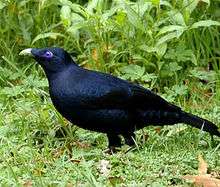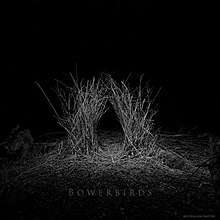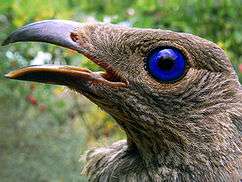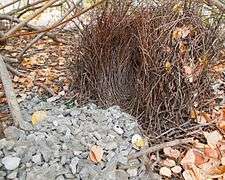Bowerbird
Bowerbirds (/ˈbaʊ.ərbɜːrd/) make up the bird family Ptilonorhynchidae. They are renowned for their unique courtship behaviour, where males build a structure and decorate it with sticks and brightly coloured objects in an attempt to attract a mate.
| Bowerbirds | |
|---|---|
 | |
| Male satin bowerbird Ptilonorhynchus violaceus | |
| Scientific classification | |
| Kingdom: | Animalia |
| Phylum: | Chordata |
| Class: | Aves |
| Order: | Passeriformes |
| Parvorder: | Corvida |
| Superfamily: | Menuroidea |
| Family: | Ptilonorhynchidae GR Gray, 1841 |
| Genera | |
|
Ailuroedus | |
The family has 20 species in eight genera.[1] These are medium to large-sized passerines, ranging from the golden bowerbird at 22 centimetres (8.7 in) and 70 grams (2.5 oz) to the great bowerbird at 40 centimetres (16 in) and 230 grams (8.1 oz). Their diet consists mainly of fruit but may also include insects (especially for nestlings), flowers, nectar and leaves in some species.[2] The satin[3] and spotted bowerbirds[4] are sometimes considered agricultural pests due to their habit of feeding on introduced fruit and vegetable crops and have occasionally been killed by affected orchardists.[4]
The bowerbirds have an Austro-Papuan distribution, with ten species endemic to New Guinea, eight endemic to Australia, and two found in both.[5] Although their distribution is centered on the tropical regions of New Guinea and northern Australia, some species extend into central, western, and southeastern Australia. They occupy a range of different habitats, including rainforest, eucalyptus and acacia forest, and shrublands.
Behaviour and ecology
The Ailuroedus catbirds are monogamous, with males raising chicks with their partner, but all other bowerbirds are polygynous, with the female building the nest and raising the young alone. These latter species are commonly dimorphic, with the female being drabber in color. Female bowerbirds build a nest by laying soft materials, such as leaves, ferns, and vine tendrils, on top of a loose foundation of sticks.

All Papuan bowerbirds lay one egg, while Australian species lay one to three with laying intervals of two days.[6][7] Bowerbird eggs are around twice the weight of those of most passerines of similar size[8][9] – for instance eggs of the satin bowerbird weigh around 19 grams (0.67 oz) as against a calculated 10 grams (0.35 oz) for a passerine weighing 150 grams (5.3 oz).[5] Eggs hatch after 19 to 24 days, depending on the species[2] and are a plain cream color for catbirds and the tooth-billed bowerbird, but in other species possess brownish wavy lines similar to eggs of Australo-Papuan babblers. In accordance with their lengthy incubation periods, bowerbirds that lay more than one egg have asynchronous hatching, but siblicide has never been observed.[6]
Bowerbirds as a group have the longest life expectancy of any passerine family with significant banding studies. The two most studied species, the green catbird and satin bowerbird, have life expectancies of around eight to ten years[10] and one satin bowerbird has been known to live for twenty-six years.[11] For comparison, the common raven, the heaviest passerine species with significant banding records, has not been known to live longer than 21 years.[12]
Courtship and mating
The most notable characteristic of bowerbirds is their extraordinarily complex courtship and mating behaviour, where males build a bower to attract mates. There are two main types of bowers. Prionodura, Amblyornis, Scenopoeetes and Archiboldia bowerbirds build so-called maypole bowers, which are constructed by placing sticks around a sapling; in the former two species these bowers have a hut-like roof.[13] Chlamydera, Sericulus and Ptilonorhynchus bowerbirds build an avenue type-bower made of two walls of vertically placed sticks.[14] Ailuroedus catbirds are the only species which do not construct either bowers or display courts.[15] In and around the bower, the male places a variety of brightly colored objects he has collected. These objects – usually different among each species – may include hundreds of shells, leaves, flowers, feathers, stones, berries, and even discarded plastic items, coins, nails, rifle shells, or pieces of glass. The males spend hours arranging this collection. Bowers within a species share a general form but do show significant variation, and the collection of objects reflects the biases of males of each species and its ability to procure items from the habitat, often stealing them from neighboring bowers. Several studies of different species have shown that colors of decorations males use on their bowers match the preferences of females.
In addition to the bower construction and ornamentation, male birds perform involved courtship displays to attract the female. Research suggests the male adjusts his performance based on success and female response.[16][17]

Mate-searching females commonly visit multiple bowers, often returning to preferred bowers several times, and watching males' elaborate courtship displays and inspecting the quality of the bower. Through this process the female reduces the set of potential mates.[18] Many females end up selecting the same male, and many under-performing males are left without copulations. Females mated with top-mating males tend to return to the male the next year and search less.[19]

It has been suggested that there is an inverse relationship between bower complexity and the brightness of plumage. There may be an evolutionary "transfer" of ornamentation in some species, from their plumage to their bowers, in order to reduce the visibility of the male and thereby its vulnerability to predation.[20] This hypothesis is not well supported because species with vastly different bower types have similar plumage. Others have suggested that the bower functioned initially as a device that benefits females by protecting them from forced copulations and thus giving them enhanced opportunity to choose males and benefits males by enhancing female willingness to visit the bower.[21] Evidence supporting this hypothesis comes from observations of Archbold's bowerbirds that have no true bower and have greatly modified their courtship so that the male is limited in his ability to mount the female without her cooperation. In tooth-billed bowerbirds that have no bowers, males may capture females out of the air and forcibly copulate with them. Once this initial function was established, bowers were then co-opted by females for other functions such as use in assessing males based on the quality of bower construction. Recent studies with robot female bowerbirds have shown that males react to female signals of discomfort during courtship by reducing the intensity of their potentially threatening courtship.[16] Young females tend to be more easily threatened by intense male courtship, and these females tend to choose males based on traits not dependent on male courtship intensity.
The high degree of effort directed at mate choice by females and the large skews in mating success directed at males with quality displays suggests that females gain important benefits from mate choice. Since males have no role in parental care and give nothing to females except sperm, it is suggested that females gain genetic benefits from their mate choice. However this has not been established, in part because of the difficulty of following offspring performance since males take seven years to reach sexual maturity. One hypothesis for the evolutionary causation of the bowerbuilding display is Hamilton and Zuk's "bright bird" hypothesis, which states that sexual ornaments are indicators of general health and heritable disease resistance.[22] Doucet and Montgomerie[23][24] determined that the male bowerbird's plumage reflectance indicates internal parasitic infection, whereas the bower quality is a measure of external parasitic infection. This would suggest that the bowerbird mating display evolved due to parasite mediated sexual selection, though there is some controversy surrounding this conclusion.[25]
This complex mating behaviour, with its highly valued types and colors of decorations, has led some researchers[26] to regard the bowerbirds as among the most behaviorally complex species of bird. It also provides some of the most compelling evidence that the extended phenotype of a species can play a role in sexual selection and indeed act as a powerful mechanism to shape its evolution, as seems to be the case for humans. Inspired by their seemingly extreme courtship rituals, Charles Darwin discussed both bowerbirds and birds-of-paradise in his writings.[27]
In addition, many species of bowerbird are superb vocal mimics. MacGregor's bowerbird, for example, has been observed imitating pigs, waterfalls, and human chatter. Satin bowerbirds commonly mimic other local species as part of their courtship display.
Bowerbirds have also been observed creating optical illusions in their bowers to appeal to mates. They arrange objects in the bower's court area from smallest to largest, creating a forced perspective which holds the attention of the female for longer. Males with objects arranged in a way that have a strong optical illusion are likely to have higher mating success.[28]
Taxonomy and systematics

Though bowerbirds have traditionally been regarded as closely related to the birds of paradise, recent molecular studies suggest that while both families are part of the great corvid radiation that took place in or near Australia-New Guinea, the bowerbirds are more distant from the birds of paradise than was once thought. DNA–DNA hybridization studies placed them close to the lyrebirds;[29] however, anatomical evidence appears to contradict this placement,[30] and the true relationship remains unclear.
Genus Ailuroedus
- Ochre-breasted catbird, Ailuroedus stonii
- White-eared catbird, Ailuroedus buccoides
- Tan-capped catbird, Ailuroedus geislerorum
- Green catbird, Ailuroedus crassirostris
- Spotted catbird, Ailuroedus maculosus
- Huon catbird, Ailuroedus astigmaticus
- Black-capped catbird, Ailuroedus melanocephalus
- Northern catbird, Ailuroedus jobiensis
- Arfak catbird, Ailuroedus arfakianus
- Black-eared catbird, Ailuroedus melanotis
Genus Scenopoeetes
- Tooth-billed catbird, Scenopoeetes dentirostris
Genus Archboldia
- Archbold's bowerbird, Archboldia papuensis
- Sanford's bowerbird, Archboldia sanfordi (This species' validity is disputed; currently considered conspecific with Archboldia papuensis in most references.)
Genus Amblyornis
- Vogelkop bowerbird, Amblyornis inornata
- MacGregor's bowerbird, Amblyornis macgregoriae
- Streaked bowerbird, Amblyornis subalaris
- Golden-fronted bowerbird, Amblyornis flavifrons
Genus Prionodura
- Golden bowerbird, Prionodura newtoniana
Genus Sericulus
- Flame bowerbird, Sericulus ardens
- Masked bowerbird, Sericulus aureus
- Fire-maned bowerbird, Sericulus bakeri
- Regent bowerbird, Sericulus chrysocephalus
Genus Ptilonorhynchus
- Satin bowerbird, Ptilonorhynchus violaceus
Genus Chlamydera
- Western bowerbird, Chlamydera guttata
- Spotted bowerbird, Chlamydera maculata
- Great bowerbird, Chlamydera nuchalis
- Yellow-breasted bowerbird, Chlamydera lauterbachi
- Fawn-breasted bowerbird, Chlamydera cerviniventris
-Note that the Ptilonorhynchid catbirds, the grey catbird (Dumetella carolinensis) and black catbird (Melanoptila glabrirostris) from the Americas, and the Abyssinian catbird (Parophasma galinieri) from Africa are only related by their common name; they belong to different families.
References
- Borgia, Gerald (June 1986). "Sexual Selection in Bowerbirds". Scientific American. 254 (6): 92–101. doi:10.1038/scientificamerican0686-92. JSTOR 24975977.
- Frith, Clifford B. (1991). Forshaw, Joseph (ed.). Encyclopedia of Animals: Birds. London: Merehurst Press. pp. 228–331. ISBN 978-1-85391-186-6.
- "Problem Wildlife". Dse.vic.gov.au. 2013-02-27. Archived from the original on 2013-04-28. Retrieved 2013-03-27.
- "Spotted Bowerbird" (PDF). Archived from the original (PDF) on 2014-02-17. Retrieved 2013-03-27.
- Rowland, Peter (2008). Bowerbirds. Australian Natural History Series. Collingwood: CSIRO Publishing. pp. 1–26. ISBN 978-0-643-09420-8.
- Higgins, P.J. and J.M. Peter (editors); Handbook of Australian, New Zealand and Antarctic Birds, Volume 6: Pardalotes to Shrike-thrushes ISBN 0-19-553762-9
- Frith, Clifford B.; "Egg laying at long intervals in bowerbirds (Ptilonorhynchidae)"
- Based on the formula of egg mass = 0.258m0.73, where m is body mass. From Rahn, H., Sotherland, P. and Paganelli, C. V., 1985. "Interrelationships between egg mass and adult body mass and metabolism among passerine birds" in Journal für Ornithologie 126:263–271.
- Hoyt, Donald F. (1979). "Practical Methods of estimating the Volume and Fresh Weight of Bird Eggs". Auk. 96 (1): 73–77.
- Species search by Australian Bird and Bat Banding Scheme
- "Satin Bowerbird". Environment.gov.au. 2007-04-13. Retrieved 2013-03-27.
- Wasser, D. E. and Sherman, P.W.; "Avian longevities and their interpretation under evolutionary theories of senescence" in Journal of Zoology 2 November 2009
- Kusmierski, Rab (September 1993). "Molecular information on bowerbird phylogeny and the evolution of exaggerated male characteristics". Journal of Evolutionary Biology. 6 (5): 737–752. doi:10.1046/j.1420-9101.1993.6050737.x.
- Kusmierski, Rab (1997-03-22). "Labile evolution of display traits in bowerbirds indicates reduced effects of phylogenetic constraint". Proc. Biol. Sci. 264 (1380): 307–13. doi:10.1098/rspb.1997.0044. PMC 1688255. PMID 9107048.
- Kusmierski, Rab (1997-03-22). "Labile evolution of display traits in bowerbirds indicates reduced effects of phylogenetic constraint". Proc Biol Sci. 264 (1380): 307–313. doi:10.1098/rspb.1997.0044. PMC 1688255. PMID 9107048.
- Patricelli, Gail L.; Coleman, Seth W.; Borgia, Gerald (January 2006). "Male satin bowerbirds, Ptilonorhynchus violaceus, adjust their display intensity in response to female startling: an experiment with robotic females". Animal Behaviour. 71 (1): 49–59. doi:10.1016/j.anbehav.2005.03.029. ISSN 0003-3472.
- Coleman, Seth W.; Patricelli, Gail L.; Borgia, Gerald (April 2004). "Variable female preferences drive complex male displays". Nature. 428 (6984): 742–745. doi:10.1038/nature02419. ISSN 0028-0836. PMID 15085130.
- Uy, J. Albert C.; Patricelli, Gail L.; Borgia, Gerald (November 2001). "Complex Mate Searching in the Satin Bowerbird Ptilonorhynchus violaceus". The American Naturalist. 158 (5): 530–542. doi:10.1086/323118. ISSN 0003-0147. PMID 18707307.
- Uy, J. Albert C.; Patricelli, Gail L.; Borgia, Gerald (2000-02-07). "Dynamic mate-searching tactic allows female satin bowerbirds Ptilonorhynchus violaceus to reduce searching". Proceedings of the Royal Society of London B: Biological Sciences. 267 (1440): 251–256. doi:10.1098/rspb.2000.0994. PMC 1690527. PMID 10714879.
- Gilliard, Ernest Thomas (July 1956). "Bower ornamentation versus plumage characters in bower-birds". Auk. 73 (3): 450–451. doi:10.2307/4082011. JSTOR 4082011.
- Kusmierski, Rab; G. Borgia; A. Uy; R.H. Crozier (1997). "Labile evolution of display traits in bowerbirds indicates reduced effects of phylogenetic constraint". Proceedings of the Royal Society of London B. 264 (1380): 307–313. doi:10.1098/rspb.1997.0044. PMC 1688255. PMID 9107048.
- Hamilton, William D; M. Zuk (1982). "Heritable true fitness and bright birds: a role for parasites?". Science. 218 (4570): 384–387. doi:10.1126/science.7123238. JSTOR 1688879. PMID 7123238.
- Doucet, Stephanie M.; R. Montgomerie (2003). "Multiple sexual ornaments in satin bowerbirds: ultraviolet plumage and bowers signal different aspects of male quality". Behavioral Ecology. 14 (4): 503–509. doi:10.1093/beheco/arg035.
- Doucet, Stephanie M.; R. Montgomerie (2003). "Structural plumage colour and parasites in satin bowerbirds Ptilonorhynchus violaceus: implications for sexual selection". Journal of Avian Biology. 34 (3): 237–242. doi:10.1034/j.1600-048x.2003.03113.x.
- Borgia, Gerald; K. Collins (1989). "Female choice for parasite-free male satin bowerbirds and the evolution of bright male plumage". Behavioral Ecology and Sociobiology. 25 (6): 445–454. doi:10.1007/bf00300191.
- Choe, J.C. (2019). Encyclopedia of Animal Behavior. Elsevier Science. ISBN 978-0-12-813252-4. Retrieved 2019-10-19.CS1 maint: ref=harv (link)
- Diamond, J. (1986). "Biology of Birds of Paradise and Bowerbirds". Annual Review of Ecology and Systematics. 17: 17–37. doi:10.1146/annurev.es.17.110186.000313.
- Maxmen, Amy (9 September 2010). "Bowerbirds trick mates with optical illusions". Nature News. doi:10.1038/news.2010.458.
- Sibley, CG; Schodde, R; Ahlquist, JE (1 January 1984). "The relationship of the Australo-Papuan Treecreepers Climacteridae as indicated by DNA-DNA hybridization". Emu. 84 (4): 236–241. doi:10.1071/MU9840236.
- Ericson, Per G.P; Christidis, Les; Irestedt, Martin; Norman, Janette A. (2002-10-01). "Systematic affinities of the lyrebirds (Passeriformes: Menura), with a novel classification of the major groups of passerine birds". Molecular Phylogenetics and Evolution. 25 (1): 53–62. doi:10.1016/S1055-7903(02)00215-4. ISSN 1055-7903.
External links
| Wikimedia Commons has media related to Ptilonorhynchidae. |
![]()
- Bowerbird videos on the Internet Bird Collection
- Bower bird nest building